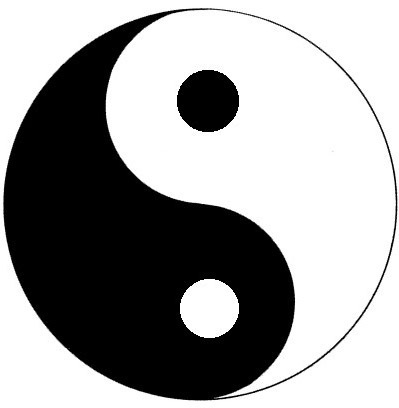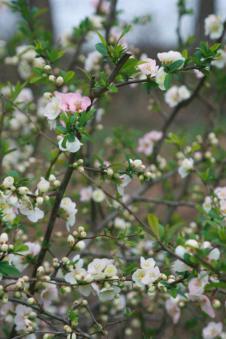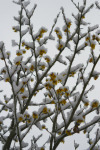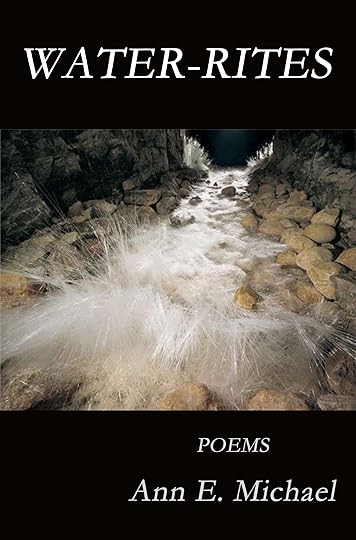Ann E. Michael's Blog, page 73
April 10, 2013
Comparison as analysis
April may be the cruelest month, may be the time of cherry blossoms hung with snow, may be the time to celebrate poetry–as if we could confine it to one month, those of us who love it–anyway, it is also the last full month of the spring college semester. After endeavoring to impart some understanding of the principles of literary analysis of poetry to my students for the past ten weeks, I assigned a short paper that taught me a great deal. Perhaps it taught my students something, as well.
It occurred to me that metaphor–indeed, most figures of speech–are based upon likenesses, direct or analogous or implied. Yet we Western thinkers are taught to observe differences first and foremost. We learn that red is different from blue, that a ball is different from a block; and I am not disputing those differences. When we speak metaphorically, however, we imply similarity instead. My students default to contrast for analysis and to similarity for description.
There’s nothing inherently wrong with that; it’s very Aristotelian. But what if we turn things 180 degrees? Think of Linnaeus, who classified so many plants and animals; he grouped life forms according to likeness. The differences branched off from the similarities. He described what was overtly or subtly similar, then analyzed for differentiation.
Any two poems have at least a few things in common, so I asked my students to do a comparison-only study, briefly, in a 2-page paper. Initially, they had a great deal of trouble with the assignment. They wanted to contrast. Their interests lay in what was noticeably different about each poem. They genuinely struggled to stay on the topic of similarity, but the outcomes were some of the best papers I have yet had from this class. A student told me that this exercise “really made me think.” 
Fascinating response, really. What does it tell us about our brains, our education, our observational instincts, that we want to stress difference before similarity? Is this a Western civilization thing, or an in-our-DNA-thing? I wonder.
The process that makes a person think, though, is a learning process for certain. Once we can recognize similarities between disparate works of art, we can perhaps recognize similarities between philosophies, religions, human beings. The very differences may become beautiful or intriguing rather than frightening or alien. We may learn to become more comfortable with variety, and more appreciative of it. I know my reading life would be much the poorer if I refused to read, try to understand, or value novels or poems that seemed challengingly “other.” I do not love all of the work I read, but everything teaches me something.
The poems below are very different. In what ways, specifically, are they alike?
Spleen (by Charles Baudelaire, tr. by Robert Lowell)
I’m the king of a rain country, rich
but sterile, young but with an old wolf’s itch,
one who escapes Fenelon’s apologues,
and kills the day in boredom with his dogs;
nothing cheers him, darts, tennis, falconry,
his people dying by the balcony;
the bawdry of the pet hermaphrodite
no longer gets him through a single night;
his bed of fleur-de-lys becomes a tomb;
even the ladies of the court, for whom
all kings are beautiful, cannot put on
shameful enough dresses for this skeleton;
the scholar who makes his gold cannot invent
washes to cleanse the poisoned element;
even in baths of blood, Rome’s legacy,
our tyrants’ solace in senility,
he cannot warm up his shot corpse, whose food
is syrup-green Lethean ooze, not blood.
~ ~
Arrival (by William Carlos Williams)
And yet one arrives somehow,
finds himself loosening the hooks of
her dress
in a strange bedroom–
feels the autumn
dropping its silk and linen leaves
about her ankles.
The tawdry veined body emerges
twisted upon itself
like a winter wind . . . !
~
(These poems are shared under the Creative Commons and are copyrighted by the estates and/or publishers of these poets)


April 5, 2013
Judging poems
During National Poetry Month, a local newspaper (Lehigh Valley Press) sponsors, with a local public radio station (WDIY), a poetry contest for children ages 6-17. This year I was one of seven people, most of us educators, on the judging panel.
Judging poetry is always a rather fraught endeavor, and when one is reading the work of novices–particularly very young ones–setting standards can be challenging. What were we looking for, exactly? How could we decide whether the writing of one 14-year-old was “better” than the work of another? How to assess the poetry of 8-year-olds?
Our coordinator and organizer began with such questions and by asking us to describe what each of us seeks in any poem–not poems by children, but any good poem. Would children’s work feature any of these attributes? Successful attempts at poetic strategies or craft, for example–we may be able to determine that a 10-year-old’s work shows signs of poetic craft. Imagery that moves beyond the expected or clichéd? Young people often prove quite capable of that part of writing.
We are experienced in the classroom, too, and can usually tell when a child’s work shows signs of being ‘overly-coached’ by a well-meaning adult. Alas, all too often an adult’s interference deadens the imaginative if occasionally grammatically-incorrect approach children take. We can also tell which poems come of a classroom assignment when we get submissions of numerous 7-line poems on “snow.” This is not to suggest that none of the poems are worthy of note: an imaginative writer of any age can probably create a lovely piece conforming to the assigned framework. But, as teachers, we found ourselves responding to the assignments themselves (“That’s clever and would work well with third-graders, too;” “They must be studying the Black Plague;” “Looks as though they made a word bank for this one;” and so on). We had to remind ourselves to look at the work itself for the earmarks of imaginative ideas and use of language.
Interestingly, first-place poems seemed obvious and agreement was usually unanimous. This was true for elementary school, middle school, and high school writers: the best work does stand out.
Choosing the second and third place poems was more difficult and resulted in lively conversation about what makes a good poem, what matters more: authenticity of experience? discernible voice? vivid imagery? clear use of craft? emotional expression? imagination? Each of the judges had useful insights that reminded me of the value of thoughtful criticism and the value of poetry-as-art.
It was also heartening to read the work of so many young people who showed a willingness to play with words, to think about aesthetics and feelings and language, and to show their work to others. I’m grateful to the teachers who took the time to introduce their students to poetry and to encourage their pupils to write.


April 1, 2013
I celebrate myself…
April is National Poetry Month in the USA, and I begin the month with Walt Whitman’s famous phrase and will attempt to duplicate the joyous urgency of his call to celebration. That means I am going to try to post just a little more frequently in April.
Poetry month began this year with a wonderful act of creative largesse on the part of a friend who sent me a poem…dedicated to me. Receiving a gift like this one is humbling; and it has been quite a long time since anyone’s written a piece for me. David Dunn, to whom my collection Water-Rites is dedicated, wrote a few poems for me or inspired (indirectly or directly) by our friendship or my family and surroundings. But he died over a decade ago, and since then I suppose I have had to learn to celebrate myself.
Not that this is a bad thing–celebrating the self–but for some of us it presents certain cultural or psychological obstacles. In this, Whitman has been an important teacher for me. As a great observer, loafer, lover of the world and all its beings, he was able to include himself among the beloved. My background, Protestant, agrarian, modest, surrounded by the biblical entreaty to remain always humble before God, combined with a natural shyness, means that I have had trouble admitting of self-celebration in any form and under any circumstances. I don’t take praise comfortably. The left hand shouldn’t know what the right hand is doing.
However, Whitman seems contented in his skin and in his world and follows a different parable as model: he does not hide his light under a bushel.

Walt Whitman in mid-life
Furthermore, his passion admits of compassion and of aesthetic appreciation for all of the “Kosmos.” Each breath, scent, texture, color, hue, person, idea, object, sentient or non-, living or inert or dead long-past or recently, religious or scientific or imagined comes to life in language through line, syntax, lists, descriptions, words. I think there is a hint of zen-like acceptance in Whitman’s most lasting poetry, the vulnerable willingness to accept all that we experience and to do so non-judgmentally.
Thank you, Beejay, for the poem. I feel inspired anew. And as I celebrate all poets and the valuable, irreplaceable, gorgeous, ancient art of poetry this month, I shalendeavor to embark upon the celebration of myself (davening to ol’ Walt with humble pleasure). Therefore, a reminder:
My book Water-Rites is still in print, and Brick Road Poetry Press sells it (as does Amazon.com, where poetry-lovers can purchase the book in e-book form for Kindle). Dawn Leas reviews it at Poets Quarterly this month. Click for the link here!
May April be full of revelations in the form of poems for you. 


March 27, 2013
Endemophilia
This poem is sort of my version of endemophilia, describing (as Albrecht defines it) “the particular love of the locally and regionally distinctive in the people of that place. It is similar to what Relph … called “existential insideness” or the deep, satisfying feeling of being truly at home with one’s place and culture.” You might want to check out Glenn Albrecht’s site for more detailed definitions and philosophical/psychological reasons for inventing names for such concepts.
My long-poem in Water-Rites, “The Valley, the Whitetail: A History,” probably fits the term endemophilia more closely than the poem I’ve posted below–which may one day appear in print if I can find a publisher for my next manuscript. But the long-poem is a little too long for a blog post.
[I have an idea: buy a copy of Water-Rites from Brick Road Poetry Press, and read it there!]
~
Suburban Georgic
A mild day in February. Good chance
there’ll be more snow or ice. Walk slowly,
note the footprint of a hosta, dormant, or
the arrow-shaped deer hoof in hardened soil.
Look more closely for the ravages and burrows
of rodentia—woodchucks, voles and mice.
You may discover where squirrels have
hidden seeds or laid waste to crocus corms—
try to restrain your wrath. Decide
how best to counter such yearly looting;
strategy keeps the mind sharp. Grubs,
for instance, in your lawn—a different tack,
and this year you may succeed, and keep
the skunks from rooting through the grass.
Weigh, in your mind and pocketbook,
the relative costs of pesticide and herbicide.
It might be the year to go organic,
though there’s even odds the dandelions will thrive.
Ease your troubled breast from lawn woes.
Raise your eyes to forsythia, to witch-hazel,
observe critically the shrubs’ bare bones,
decide what needs the kindest cut,
find your saw and pruners, time to oil
and sharpen—your fingers itch—
but it’s a little soon. To assuage your
yearning, cut back the redtwig osier
so its new growth will flush crimson.
Consider forcing blooms indoors—
aren’t there soft, small swellings on
the slim wands of pussywillow?
When the next storm hits, dream of columbine
and narcissus. Get out your Horace, and wait.

quince blossoms
~
© 2008 Ann E. Michael
~
Waiting, in the place I call home, for spring.


March 22, 2013
Toponesia and poem
Here is a poem by Virginia Hamilton Adair that demonstrates, perhaps, the idea of “toponesia”–loss of connection with place. The speaker recalls the beloved beach in its decay and in its beauty; she also recognizes that the tide erases all–talk about amnesia!
Buckroe, After the Season, 1942
Past the fourth cloverleaf, by dwindling roads
At last we came into the unleashed wind;
The Chesapeake rose to meet us at a dead end
Beyond the carnival wheels and gingerbread.
Forsaken by summer, the wharf. The oil-green waves
Flung yellow foam and sucked at disheveled sand.
Small fish stank in the sun, and nervous droves
Of cloud hastened their shadows over bay and land.
Beyond the NO DUMPING sign in its surf of cans
And the rotting boat with nettles to the rails,
The horse dung garlanded with jeweling flies
And papers blown like a fleet of shipless sails,
We pushed into an overworld of wind and light
Where sky unfettered ran wild from earth to noon,
And the tethered heart broke loose and rose like a kite
From sands that borrowed diamonds from the sun.
We were empty and pure as shells that air-drenched hour,
Heedless as waves that swell at the shore and fall,
Pliant as sea-grass, the rapt inheritors
Of a land without memory, where tide erases all.
from Ants on the Melon. Copyright © 1996 by Virginia Hamilton Adair


Here is a poem by Virginia Hamilton Adair that demonstra...
Here is a poem by Virginia Hamilton Adair that demonstrates, perhaps, the idea of “toponesia”–loss of connection with place. The speaker recalls the beloved beach in its decay and in its beauty; she also recognizes that the tide erases all–talk about amnesia!
Buckroe, After the Season, 1942
Past the fourth cloverleaf, by dwindling roads
At last we came into the unleashed wind;
The Chesapeake rose to meet us at a dead end
Beyond the carnival wheels and gingerbread.
Forsaken by summer, the wharf. The oil-green waves
Flung yellow foam and sucked at disheveled sand.
Small fish stank in the sun, and nervous droves
Of cloud hastened their shadows over bay and land.
Beyond the NO DUMPING sign in its surf of cans
And the rotting boat with nettles to the rails,
The horse dung garlanded with jeweling flies
And papers blown like a fleet of shipless sails,
We pushed into an overworld of wind and light
Where sky unfettered ran wild from earth to noon,
And the tethered heart broke loose and rose like a kite
From sands that borrowed diamonds from the sun.
We were empty and pure as shells that air-drenched hour,
Heedless as waves that swell at the shore and fall,
Pliant as sea-grass, the rapt inheritors
Of a land without memory, where tide erases all.
from Ants on the Melon. Copyright © 1996 by Virginia Hamilton Adair


March 14, 2013
Homescape poems: Solastalgia
Note–The poems below are used only as illustrations and used by virtue of the Creative Commons theory; the copyrights belong to the authors or their executors.
~
I’m thinking about the nostalgic overtones of the “changed” homescape here, or the notion of solastalgia as coined by Glenn Albrecht (see earlier post). At first I planned to use a poem with overt environmental themes (as of the home that has been denuded, altered, destroyed–many good poems exist on that theme). Then I thought to look more obliquely at the idea of solastalgia as an emotional state, for home is deeply freighted with psyche.
One form of “solastalgia” is represented here, I think, in Philip Larkin’s “Home Is So Sad”:
Home Is So Sad
Home is so sad. It stays as it was left,
Shaped to the comfort of the last to go
As if to win them back. Instead, bereft
Of anyone to please, it withers so,
Having no heart to put aside the theft
And turns again to what it started as,
A joyous shot at how things ought to be,
Long fallen wide. You can see how it was:
Look at the pictures and the cutlery.
The music in the piano stool. That vase.
~
Another aspect of solastalgia, in this section of Gary Snyder’s “Four Poems for Robin,” relates to the homeplace in the form of a relationship, one bound up with the excitement of youth, college, the orchard with its tall dry grasses and love’s “grave, awed intensity.” Yase village is located near Kyoto; the speaker of the poem identifies where (and when: December) he resides while reflecting on an autumn day in his past.
December at Yase
You said, that October,
In the tall dry grass by the orchard
When you chose to be free,
“Again someday, maybe ten years.”
After college I saw you
One time. You were strange.
And I was obsessed with a plan.
Now ten years and more have
Gone by: I’ve always known
where you were–
I might have gone to you
Hoping to win your love back.
You still are single.
I didn’t.
I thought I must make it alone. I
Have done that.
Only in dream, like this dawn,
Does the grave, awed intensity
Of our young love
Return to my mind, to my flesh.
We had what the others
All crave and seek for;
We left it behind at nineteen.
I feel ancient, as though I had
Lived many lives.
And may never now know
If I am a fool
Or have done what my
karma demands.
~
I’d be interested in finding out which poems you consider solastalgic. Meanwhile, I am going to browse my collection for poems that are endomophilic…


March 12, 2013
AWP follow-up

winterhazel
Snow fell on Boston. Not a big snow, however, and rather typical for a late-winter storm: damp, swirling but not biting, swift-melting once the sun appeared two days later. Early Friday morning, I trudged with a friend over the as-yet unshoveled sidewalks to breakfast on Newbury Street at Steve’s. We met with conference buddies who are all members of the WOM-PO [women's poetry] listserv. It is lovely to meet face-to-face people who have been virtual colleagues and splendid to discuss poetry over a good breakfast.
~
It is also a relief to realize that I have finally learned how to manage conference-going. It is all a matter of pacing and, I suppose, of taking poet William Stafford’s advice and lowering one’s expectations. The hardest challenge is making the choice between blowing the budget on terrific food (in a big city, wonderful restaurants abound) or on books, because the bookfair at the Associated Writing Programs’ annual conference is enough to inspire swooning among literary bibliophiles.
In three huge exhibit rooms, small presses and literary and university presses displayed chapbooks, literary journals, and books that range from minuscule to tabloid-sized, books that are handmade, letter-pressed, offset, print-on-demand, stapled, ribbon-sewn, die-cut, fancy-boxed, reprinted, spare, florid, illustrated, edgy, deckle-edged, marbled, second-hand, one-of-a-kind, limited-edition, mass produced, commercial, educational…in all genres including mixed-genre, collaborative, collage, anthology, with an emphasis more on the literary than the commercial text. These books can be devilishly hard to locate, even with the existence of Amazon and online sellers; and holding them in your hands is a far more convincing sell than seeing a picture file on your computer screen.
Heaven for poetry-readers, there are also wonderful creative non-fiction books, collections of short stories, novels, books on prosody and poetics, the craft of writing, on creativity and inspiration and toil and revision and on the complex and controversial topic of teaching writing. Oh, and there are people, too. Most of the attendees are writers of one stripe or another who are congenial and curious or else walking about with the glazed expression of the overwhelmed.
Or some combination of the two.
~
I exercised considerable restraint and managed not to load my bedside table with two months or more of reading material (see a related post here). And I got some terrific ideas for teaching writing to college students and found some wonderful poets whose work I want to study. The last night of the conference, I listened to the mesmerizing Anne Carson read an indescribable take-down of the fifth book of Proust’s À la recherche du temps perdu, the section titled The Captive (Albertine). It’s been years since I read Proust, which I did almost out of stubbornness in my junior year of college, but the book came back vividly enhanced by Carson’s peculiar approach to pacing, language, scholarship, whimsy and satire. I like what the Poetry Foundation’s biography says about her after the release of her text The Autobiography of Red:
According to John D’Agata in the Boston Review, the book “first stunned the classics community as a work of Greek scholarship; then it stunned the nonfiction community as an inspired return to the lyrically based essays once produced by Seneca, Montaigne, and Emerson; and then, and only then, deep into the 1990s, reissued as “literature”and redesigned for an entirely new audience, it finally stunned the poets.” D’Agata sees Carson’s earlier work as an essayist everywhere in her poetry, along with her deep absorption in Classical languages. Carson’s work, D’Agata alleges, asks one to consider “how prosaic, rhetorical, or argumentative can a poem be before it becomes something else altogether, before it reverts to prose, to essay?”
~
Altogether, Boston provided nourishment of many kinds: gustatory, intellectual, emotional, poetical…food for thought.


March 11, 2013
An eBook arrives
Thanks to Brick Road Poetry Press, there is now a Kindle version of my poetry collection Water-Rites. I think the only place to purchase it is Amazon.com and the link is here: Water-Rites ebook.
I haven’t forgotten about posting poems of place-longing and homescapes. Just feeling a bit short on time this week.


March 5, 2013
Endemophilia, toponesia, psychoterric states
Thanks to poet Annie Finch, I came across a thoughtful essay in Aeon magazine–an exercise in synthesis and interdisciplinary thinking that connects with Naess and his notion of ecosophy; and with Bachelard and others whose work I have lately been reading and thinking about. Liam Heneghan combines ecology, botany and topography with Winnie-the-Pooh and explores transience and trans-placement from several viewpoints. He looks at how so many of us are transplants, foreign “invaders,” culturally and biologically, and asks us to think about how we feel about place–home-place, in particular.
Not all of us connect with the concept of a home-dwelling anymore; but if we do so, that place is generally closely associated with childhood, observes Heneghan. He cites environmental philosopher Glenn Albrecht and says:
…we do not yet have an adequate vocabulary to address our ‘psychoterric’ states — or how the state of the Earth relates to our states of mind. To balance the negative psychological state of ‘nostalgia’, a couple of years ago Albrecht proposed ‘endemophilia’ (the sense of being truly at home within one’s place and culture — or ‘homewellness’). To balance the term ‘topophilia’, a love of place, Albrecht opposes ‘solastalgia’ — the desolate feeling associated with the chronic decline of a homescape. Solastalgia names the emotions we have at the loss of species and habitats through climate change and other environmental changes. We should all expect a lot more of it.
I do know those feelings, and I feel happy to have terms for them! Yet I argue that we do have an adequate vocabulary for how the state of the Earth relates to our states of mind, and that vocabulary is artistic. I believe the finest expression of these kinds of emotional-memory sensations can be found mainly through art. My task for myself in the coming weeks is to gather a few examples of endemophilia, solastalgia, and other “psychoterric states” in poetry. I’ve already got a few in mind.
Please read Heneghan’s essay if ecopoetics or the notion of homescape appeals to you.






